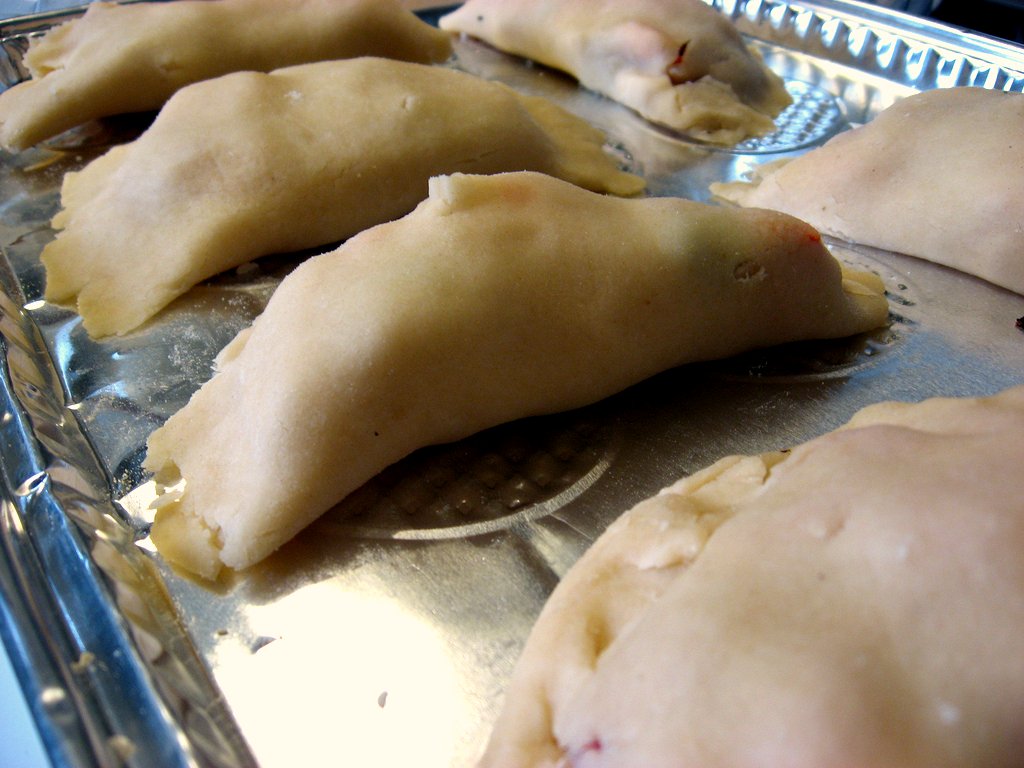Tuesday, May 4, 2010
thinly sliced beef, root vegetables, and peas in a traditional flaky pastry
With this recipe, I went with tradition. This is not my normal path in cooking. Tampering with recipes is often the best part. But Cornish pasties have tradition and history and they have knockers--anyway if I tampered with them much I wouldn't be able to say I'd made real Cornish pasties. Though some might argue that because I'm not Cornish, and I did tamper with them a little, and because these were for Easter frolicking and not tin miners... but we ignore such people, don't we?
The "traditional" Cornish pastry has a thick crust. It's shaped like a half moon and crimped along the curved side. Why? The story goes that the tin miners, covered in mine dust and arsenic, would hold the pasties by the thick crust to avoid getting the dirt and poison all over their lunch. After they had eaten down to the rim, they would throw the crimped crust down the mine shafts to appease the knockers, fey creatures who scampered about the mines stealing tools and causing mischief. (The knocking sound of the earth and timbers shaking before a tunnel collapsed were attributed to the knockers, who were either causing the disaster or warning of it).
The normal filling is thinly sliced beef, onions, and rutabagas (I think; they kept calling them Swedish turnips, but I think rutabagas were what they meant). I broke the rules and added carrots and peas, but I figured that wasn't too large a lapse. The filling is put into the pastry raw. Yes, even the beef, which I wasn't too comfortable with. The baking time is quite substantial, though, and the meat sliced very thin, so there isn't actually anything much to worry about. Sometimes a thin wall of pastry was added to split the insides into two parts so that a second, sweet filling (dried fruit was common) could be added for dessert. The initials of the lucky guy who got this for his lunch were carved over the dessert side, so he knew where to bite first.
If I make this again, I think I will part ways with tradition and add more spices. I might even marinade the meat. I also think experimenting with the dessert pocket idea would be quite fun. These were tasty (I was pleasantly surprised by the depth of flavor the rutabagas gave them) and quite filling, but they could use a little more character. But after a long hike, or a day in the tin mines, they would certainly hit the spot.
Cornish Pasties
1 onion, thinly sliced into cresents
1 rutabaga, thinly sliced
1 potato, thinly sliced
1 carrot, thinly sliced
1/2 lb beef, thinly sliced
1/2 C peas
4 C flour
1 tsp salt
1 C shortening
1/2 C butter, salted
water as needed
1 egg
2 Tb milk (I used buttermilk, because I had it, but milk or water would work fine)
Knead the shortening and butter into the flour and salt. (You're going to get dirty. It's okay. Have fun. Paint flour stripes on your cheeks and try to turn the noses of your friends white). Add water until it forms a thick dough that holds together.
Stash the dough in the fridge while you assemble the filling and chop everything. We want the fats as cold as possible, because we don't want them melting while we roll them out. Whisk the one egg and 2 Tb milk together. When you're done, retrieve the now-chilled dough.
Sprinkle a flat clean surface with flour. Take a chunk of dough and roll it out into a thin circle. (Yes, we used a Pillsbury pizza dough can for our rolling pin. Welcome to college.)
Also: those hands? Those are the hands of the awesome awesome GS, one of my favorite brilliant polymaths, and a wonderfully nice guy to boot. He did so much of the work on these.
On the rolled out dough lay a small layer of veggies and a small layer of the raw beef. Fold the dough over and crimp the edges. Transfer it to your baking pan. Brush on the egg wash so they'll bake up golden and cut some slices in the top so that the steam can escape.
Repeat, repeat, repeat.
Bake for 15 minutes at 400 degrees, then drop the temperature to 350 and bake for 20-25 minutes more. They're tasty piping hot or cold.
Have any of you ever had a real Cornish pasty? What other stuffed foods are you fond of? Or traditional UK fare?
Subscribe to:
Post Comments (Atom)





No comments:
Post a Comment
I'd love to hear from you! Share thoughts, comments, reminisces of delicious things you've eaten, opinions, suggestions, knowledge, questions...